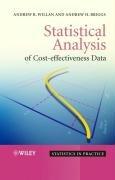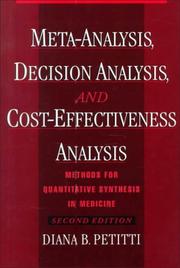| Listing 1 - 10 of 37 | << page >> |
Sort by
|
Book
Year: 2006 Publisher: Cheltenham, UK ; Northampton, MA Edward Elgar
Abstract | Keywords | Export | Availability | Bookmark
 Loading...
Loading...Choose an application
- Reference Manager
- EndNote
- RefWorks (Direct export to RefWorks)
Benefitcost analysis (BCA) is the best technique for analyzing proposed or previously enacted projects to determine whether undertaking them is in the public interest, or for choosing between two or more mutually exclusive projects. An introduction to BCA for students as well as practitioners, this accessible volume describes the underlying economic theory and legal and philosophical foundations of BCA.BCA provides an objective framework around which discussion, correction and amendment can take place. Stated simply, it is the calculation of values for all the inputs into and outputs from a project and then the subtraction of the first from the second. The authors goal here is to take the mystery out of the process. They discuss practical issues of market-based valuation and aggregation, non-market valuation, practical applications of general equilibrium models, issues in discounting, and the impacts of risk and uncertainty in BCA. They also provide a list of resources and case studies looking at ethanol and the use of cellular phones by drivers.Straightforward in style and cutting-edge in coverage, this volume will be highly usable both as a text and a reference. Advanced undergraduates and masters students in public policy, public administration, economics and health care administration programs will find this a valuable resource. It will also be of great use to agencies that perform benefitcost analyses.
Book
Year: 2006 Publisher: Cheltenham, UK ; Northampton, MA Edward Elgar
Abstract | Keywords | Export | Availability | Bookmark
 Loading...
Loading...Choose an application
- Reference Manager
- EndNote
- RefWorks (Direct export to RefWorks)
The author succeeds in bringing together many interesting real-life applications of CBA in various areas (including among others health, environment and transportation). The examples are well chosen to illustrate the basic issues and show clearly the crucial importance of theoretical and methodological assumptions. Moreover, they are presented in an accessible and attractive way. For those who know already the principles of CBA, these applications are stimulating and enjoyable reading. Erik Schokkaert, Tijdschrift voor Economie en ManagementThis fully updated new edition continues in the vein of its predecessor by viewing costbenefit analysis as applied welfare economics, while at the same time building on the earlier framework by extending the theory and providing further applications in each chapter.New for this edition are analyses of theory related applications in mental health, condom social marketing programs, female primary education as a means of preventing HIV/AIDS and the pricing of natural gas. Presented in an integrated manner, the theoretical concepts are constructed around the main building blocks of CBA, such as shadow pricing, distribution weights, the social discount rate and the marginal cost of public funds.This edition will cement the books place as a major and accessible text in the field and will be of great interest to graduate and undergraduate students of welfare economics and microeconomic theory, as well as government economists involved with any area of public policy.
Book
Year: 1966 Publisher: Paris Dunod
Abstract | Keywords | Export | Availability | Bookmark
 Loading...
Loading...Choose an application
- Reference Manager
- EndNote
- RefWorks (Direct export to RefWorks)
Financial analysis --- cost benefit analysis --- value [economic concept] --- cost-effectiveness analysis
Book
ISBN: 9789276476238 9789240049239 Year: 2022 Publisher: Brussels : Paris : European Commission, OECD Publishing,
Abstract | Keywords | Export | Availability | Bookmark
 Loading...
Loading...Choose an application
- Reference Manager
- EndNote
- RefWorks (Direct export to RefWorks)
A System of Health Accounts 2011 provides a systematic description of the financial flows related to the consumption of health care goods and services. As demands for information increase and more countries implement and institutionalise health accounts according to the system, the data produced are expected to be more comparable, more detailed and more policy relevant. This publication summarises the System of Health Accounts 2011 (SHA 2011) Manual, which was jointly produced by OECD, the European Commission and WHO. The SHA 2011 Manual itself draws inspiration from and builds on the original manual, published in 2000, and the Gui de to Producing National Health Accounts (2003) to create a single global framework for producing health expenditure accounts that can help track resource flows from sources to uses. The manual is the result of a four-year collaborative effort between OECD, Eurostat and WHO, and sets out in more detail the boundaries, the definitions and the concepts responding to health care systems around the globe - from the simplest to the more complicated.
health care system. --- health expenditure. --- public-private partnership. --- national accounts. --- cost-effectiveness analysis.

ISBN: 9780470856260 Year: 2006 Publisher: Chichester Wiley
Abstract | Keywords | Export | Availability | Bookmark
 Loading...
Loading...Choose an application
- Reference Manager
- EndNote
- RefWorks (Direct export to RefWorks)
The statistical analysis of cost-effectiveness data is becoming increasingly important within health and medical research. Statistical Analysis of Cost-Effectiveness Data provides a practical book that synthesises the huge amount of research that has taken place in the area over the last two decades. Comprising an up-to-date overview of the statistical analysis of cost-effectiveness data, the book is supported by numerous worked examples from the authors own experience. It has been written in a style suitable for medical statisticians and health care professionals alike. Key features include: an overview of statistical methods used in the analysis of cost-effectiveness data. coverage of Bayesian methodology. illustrated throughout by worked examples using real data. suitability for health care professionals with limited statistical knowledge. discussion of software used for data analysis. An essential reference for biostatisticians and health economists engaged in cost-effectiveness analysis of health-care interventions, both in academia and industry. Also of interest to graduate students of biostatistics, public health and economics.
Book
ISBN: 9781906461171 Year: 2009 Publisher: London The Health Foundation
Abstract | Keywords | Export | Availability | Bookmark
 Loading...
Loading...Choose an application
- Reference Manager
- EndNote
- RefWorks (Direct export to RefWorks)
This report reviews the evidence of whether improving quality can also save money for health service providers. It explores the cost saving potential of initiatives to improve quality and the barriers to success.
W 84.4 Quality of health care (General) --- England --- Health Care Costs --- Cost-effectiveness analysis --- Quality improvement --- Review Literature
Book
Abstract | Keywords | Export | Availability | Bookmark
 Loading...
Loading...Choose an application
- Reference Manager
- EndNote
- RefWorks (Direct export to RefWorks)
As evidence from rigorous impact evaluations grows in development, there have been more calls to complement impact evaluation analysis with cost analysis, so that policy makers can make investment decisions based on costs as well as impacts. This paper discusses important considerations for implementing cost-effectiveness analysis in the policy making process. The analysis is applied in the context of education interventions, although the findings generalize to other areas. First, the paper demonstrates a systematic method for characterizing the sensitivity of impact estimates. Second, the concept of context-specificity is applied to cost measurement: program costs vary greatly across contexts-both within and across countries-and with program complexity. The paper shows how adapting a single cost ingredient across settings dramatically shifts cost-effectiveness measures. Third, the paper provides evidence that interventions with fewer beneficiaries tend to have higher per-beneficiary costs, resulting in potential cost overestimates when extrapolating to large-scale applications. At the same time, recall bias may result in cost underestimates. The paper also discusses other challenges in measuring and extrapolating cost-effectiveness measures. For cost-effectiveness analysis to be useful, policy makers will require detailed, comparable, and timely cost reporting, as well as significant effort to ensure costs are relevant to the local environment.
Cost-Effectiveness Analysis --- Education --- Education for All --- Impact Evaluation --- Public Sector Development --- Teaching and Learning --- Tertiary Education --- Transport --- Transport Economics Policy and Planning

ISBN: 9780195133646 Year: 2000 Publisher: Oxford ; Melbourne ; New York Oxford University Press - OUP
Abstract | Keywords | Export | Availability | Bookmark
 Loading...
Loading...Choose an application
- Reference Manager
- EndNote
- RefWorks (Direct export to RefWorks)
Book
ISBN: 9789075828115 Year: 2005 Publisher: Leuven Leuven Katholieke Universiteit Leuven (KUL) ACCO
Abstract | Keywords | Export | Availability | Bookmark
 Loading...
Loading...Choose an application
- Reference Manager
- EndNote
- RefWorks (Direct export to RefWorks)
Aged --- Administration, Oral --- Belgium --- Physicians, Family --- Anticoagulants --- Therapy --- drug therapy --- Drug Monitoring --- Cost-effectiveness analysis --- QV 193 Anticoagulants --- Physician's Practice Patterns --- Costs and Cost Analysis --- Quality of Health Care --- Clinical Trials
Book
Year: 2010 Publisher: London The Health Foundation
Abstract | Keywords | Export | Availability | Bookmark
 Loading...
Loading...Choose an application
- Reference Manager
- EndNote
- RefWorks (Direct export to RefWorks)
The introduction in 2004 of the Quality and Outcomes Framework (QOF) in UK general practice represents one of the most ambitious efforts to measure and incentivise quality improvements in primary care. This report takes advantage of a large database of over 50 million English citizens to determine whether the levels of QOF attainment in general practices have led to improvements in two major outcomes: mortality and the costs of hospital inpatient and outpatient use. Our findings are that primary care performance improvements are associated with some modest but measurable improvements in subsequent outcomes and costs.
| Listing 1 - 10 of 37 | << page >> |
Sort by
|

 Search
Search Feedback
Feedback About UniCat
About UniCat  Help
Help News
News